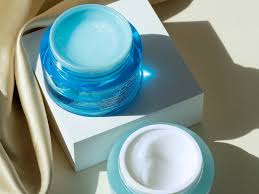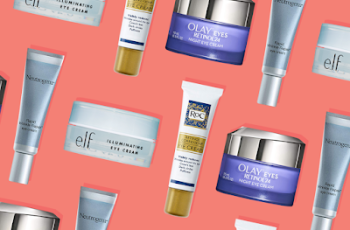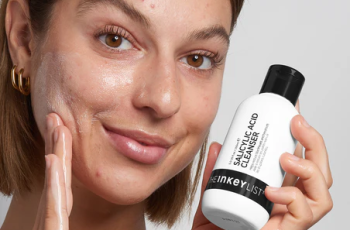
The Science of Dimethicone in Skincare
Dimethicone is a silicone-based ingredient that was once valued for its texture-enhancing properties in skincare.
Despite its versatility and popularity, many companies and consumers have avoided using dimethicone in skincare due to concerns about its potential impact on skin health and the environment.
Learn why more and more people are seeking out products that are free of dimethicone and learn the science about dimethicone here!
If you don’t know, the best way to know if a product or ingredient is right for you is to take a free Baumann Skin Type Test!
Read on to learn how dimethicone works and why some people avoid it in their skincare.
What is Dimethicone?
Dimethicone is a silicon-based polymer, commonly known as silicone. Its name indicates that it is a silicon-based molecule with two methyl groups (Di=2, Methi=Methyl, Cone=Silicon).
The structure above shows that oxygen binds two silicon-based molecules into one molecule.
This compound has a smooth texture and was once commonly found in moisturizers and other cream products.
Recently, this ingredient has fallen out of favor due to its impact on the environment and the increasing availability of quality alternatives.
If you’re interested in a dimethicone-free moisturizer, you can find our entire range here!
We also offer a full range of sunscreens and other SPF products that are dimethicone-free!
Before we get into the reasons for the increasing use of dimethicone, it’s important to first understand why it was used in the first place.
Why Dimethicone Is Used in Skincare
For decades, dimethicone has been used as a texturizing additive in cosmetics and skincare products. Although dimethicone is no longer popular, here are some of the reasons why it was once so popular:
Humectant: By forming a protective layer on the skin, dimethicone prevents water loss and keeps the skin hydrated.
Smoothing effect: It gives skincare a silky texture and is non-greasy. Dimethicone is not greasy like many other creamy ingredients.
Protective properties: Dimethicone acts as a barrier against environmental pollutants, protecting the skin from external irritants like dirt or smoke.
Wrinkle-smoothing: The ability to fill fine lines and wrinkles can make skin look temporarily smoother—a highly sought-after property in anti-aging skin care products.
It actually does little to prevent skin aging. It’s like filling a crack in a wall with frosting; it’s a very temporary solution.
Knowing these benefits explains why dimethicone has been a go-to ingredient for years.
However, the evolving skin care industry is characterized by a greater focus on ingredient safety and environmental responsibility.
Some are interested in more than just dimethicone because of their responsibility to each other and the environment.
Why is dimethicone considered harmful?
Dimethicone has gone from being a skin care product to an outlier due to personal skin issues and general environmental influences.
Here are some reasons consumers and formulators use more than dimethicone:
Potential skin irritation: Although relatively rare, dimethicone can cause skin irritation or allergic reactions. Although this problem only occurs on extremely sensitive skin, it still exists.
Comedogenicity: Due to dimethicone’s occlusive effect, it can trap sebum, dirt, and other impurities under the skin in some cases.
This issue is particularly important for people with oily skin or those prone to acne. That’s why it’s so important to know your Bowman skin type!
Environmental impact: Dimethicone is not biodegradable. Dimethicone does not naturally break down when handled. Some risks to marine life are particularly noteworthy.
This ingredient has made a significant contribution to the discussion of the ecological footprint of the cosmetics industry.
Oral issues: Studies by the Cosmetic Ingredient Review Panel showed a decrease in muscle mass and testicular size after oral administration in male subjects.
However, these results only apply to oral administration. Applying dimethicone to the skin does not seem to cause this shrinkage.
Alternatives to Dimethicone
Advances in green chemistry and biotechnology have made alternatives to dimethicone more accessible.
As dimethicone gradually loses popularity, new and old ingredients are gaining traction in the skincare space. In my opinion, the most promising alternatives include:
Plant oils: Ingredients from natural sources, such as sunflower seed oil, coconut oil, marula oil, rosehip oil, etc., are a promising alternative.
They offer similar benefits in terms of skin feel and moisture supply, but are more environmentally friendly.
Biodegradable Silicones: Innovations in silicone chemistry have led to the development of biodegradable silicones that offer nearly identical benefits to dimethicone, but without the environmental impact.
Dimethicone in Hair Care
Dimethicone in Hair Care
While the use of dimethicone in skin care products has been widely discussed, its use in hair care products deserves special attention.
Known for their conditioning properties and ability to improve hair quality, dimethicone is a common ingredient in shampoos, conditioners, and styling products.
However, just like their use in skin care, understanding how they work and why they should be avoided can help consumers make informed decisions.
Benefits of Dimethicone in Hair Care
Despite concerns about dimethicone, dimethicone is generally considered to have many benefits for hair:
Smoothness and Shine: Dimethicone coats hair strands, making them appear smooth and shiny. This effect not only makes hair shiny, but it also helps detangle and reduce frizz.
Protects: By forming a protective barrier around the hair shaft, dimethicone shields hair from environmental influences such as pollutants and UV rays.
This barrier can help keep hair healthy and prevent damage.
Moisturizes: Similar to skincare, dimethicone helps retain moisture, which is especially beneficial for dry and damaged hair because it supports hydration and prevents further moisture loss.
Improves Care: It is a key ingredient in many conditioners and deep conditioning products, helping to make hair overall soft and manageable, making styling easier and more effective.
Dimethicone’s contribution to hair care demonstrates its versatility as an ingredient in beauty and personal care formulations.
Despite its significant benefits, it is important to be aware of its potential drawbacks for the sake of hair health. The beauty industry is constantly evolving.
The development of innovative, sustainable alternatives may open up new opportunities to achieve desired hair care results without compromising environmental sustainability or hair health.
Risks of Dimethicone in Hair Products
Despite its many benefits, using dimethicone in hair products also comes with some aspects that users should consider:
Potential for accumulation: Over time, dimethicone can build up on the hair shaft, causing hair to weigh down and appear limp.
To remove these deposits, a special cleansing shampoo may be necessary, which strips the hair and scalp of natural oils.
Porosity and hair type sensitivity: The effectiveness of dimethicone varies by hair type.
While it can provide needed moisture and tame frizz for thick, coarse hair, it can be too heavy for fine hair, causing it to be greasy and lack volume.
Environmental concerns: Similar to skin care products, the environmental impact of dimethicone can affect its use in hair products due to its non-biodegradable nature.
These concerns highlight the need for sustainable processes and alternatives in product formulations.
Alternatives to dimethicone in hair care are: argan oil, coconut oil, cocoa butter, safflower oil, sesame oil, and these cleansing oils.
Choosing the Best Skincare
Choosing the Best Skincare
A nuanced understanding of ingredients like dimethicone can help make informed skincare decisions that balance personal health goals with ethical and environmental considerations.
Personalized skincare based on concepts like the Baumann Skin Type Test is essential to making this effective decision. Learn your skin type today with your free Baumann Skin Type Test!
Conclusion
The discussion around dimethicone reflects a broader interest in informed, conscious skincare.
The excitement around this ingredient shows that our impact on the environment is important to manufacturers and consumers alike.
Skincare science is constantly evolving, and new alternatives to harmful ingredients are being researched every day.
To ensure you only use ingredients that are safe for your skin type, always consider your Baumann skin type when shopping. You can find out for free with our quiz!


